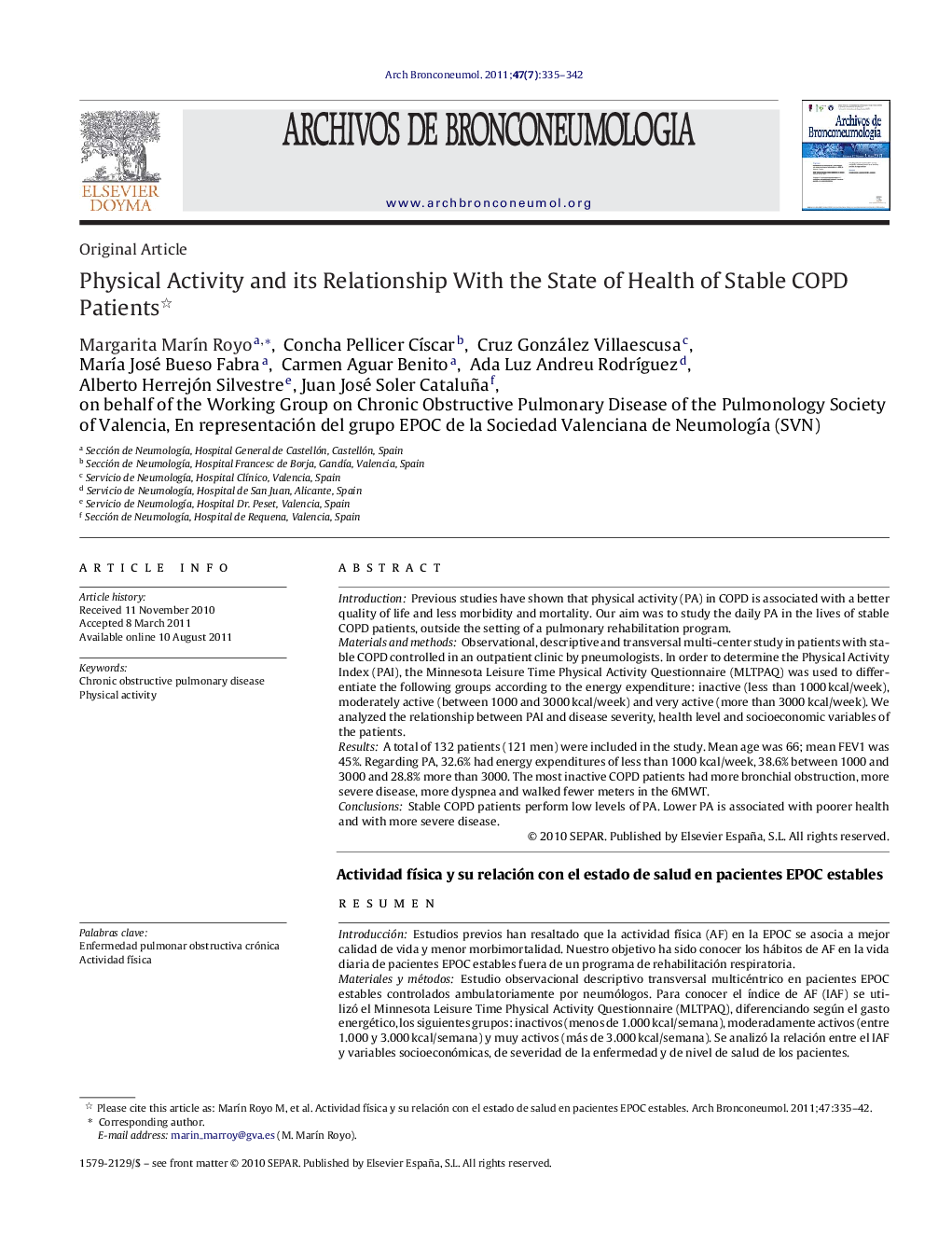| Article ID | Journal | Published Year | Pages | File Type |
|---|---|---|---|---|
| 4206214 | Archivos de Bronconeumología (English Edition) | 2011 | 8 Pages |
IntroductionPrevious studies have shown that physical activity (PA) in COPD is associated with a better quality of life and less morbidity and mortality. Our aim was to study the daily PA in the lives of stable COPD patients, outside the setting of a pulmonary rehabilitation program.Materials and methodsObservational, descriptive and transversal multi-center study in patients with stable COPD controlled in an outpatient clinic by pneumologists. In order to determine the Physical Activity Index (PAI), the Minnesota Leisure Time Physical Activity Questionnaire (MLTPAQ) was used to differentiate the following groups according to the energy expenditure: inactive (less than 1000 kcal/week), moderately active (between 1000 and 3000 kcal/week) and very active (more than 3000 kcal/week). We analyzed the relationship between PAI and disease severity, health level and socioeconomic variables of the patients.ResultsA total of 132 patients (121 men) were included in the study. Mean age was 66; mean FEV1 was 45%. Regarding PA, 32.6% had energy expenditures of less than 1000 kcal/week, 38.6% between 1000 and 3000 and 28.8% more than 3000. The most inactive COPD patients had more bronchial obstruction, more severe disease, more dyspnea and walked fewer meters in the 6MWT.ConclusionsStable COPD patients perform low levels of PA. Lower PA is associated with poorer health and with more severe disease.
ResumenIntroducciónEstudios previos han resaltado que la actividad física (AF) en la EPOC se asocia a mejor calidad de vida y menor morbimortalidad. Nuestro objetivo ha sido conocer los hábitos de AF en la vida diaria de pacientes EPOC estables fuera de un programa de rehabilitación respiratoria.Materiales y métodosEstudio observacional descriptivo transversal multicéntrico en pacientes EPOC estables controlados ambulatoriamente por neumólogos. Para conocer el índice de AF (IAF) se utilizó el Minnesota Leisure Time Physical Activity Questionnaire (MLTPAQ), diferenciando según el gasto energético, los siguientes grupos: inactivos (menos de 1.000 kcal/semana), moderadamente activos (entre 1.000 y 3.000 kcal/semana) y muy activos (más de 3.000 kcal/semana). Se analizó la relación entre el IAF y variables socioeconómicas, de severidad de la enfermedad y de nivel de salud de los pacientes.ResultadosSe incluyó a 132 pacientes (121 varones). Edad media: 66.3 años, FEV1 medio 45%. Un 32,6% de ellos realizaba una AF menor de 1.000 kcal/semana, un 38,6% entre 1.000 y 3.000 y el 28,8% más de 3.000. Los pacientes EPOC más inactivos, tenían mayor obstrucción bronquial, una enfermedad más severa, referían más disnea y caminaban menos metros en el 6MWT.ConclusionesLos pacientes EPOC estables realizan un bajo nivel de AF. Una menor AF se asocia con un peor estado de salud y con una mayor gravedad de la enfermedad.
